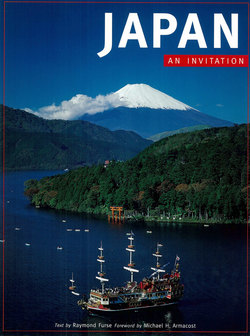Читать книгу Japan An Invitation - Raymond Furse - Страница 7
На сайте Литреса книга снята с продажи.
ОглавлениеTHE YAMATO NATION
ACCORDING TO ancient chronicles, the largest of the islands created by the gods Izanagi and Izanami was dubbed Yamato. Amaterasu, the Sun Goddess, later dispatched her grandson Ninigi to rule over this land, bestowing upon him three symbols of divine authority: a mirror, sword, and jewels, regalia which are still identified with the imperial family. Ninigi's grandson Jimmu finally succeeded in conquering Yamato, ascending the earthly throne in 660 B.C. While Jimmu may have been an actual historical personage, it is certain that this account of his deeds was fabricated at a much later date, probably to endow Japan with an antiquity comparable to that of neighboring China.
The original meaning or the name Yamato is unclear; one theory is that it derives from the Japanese for "mountain gate." The name probably first designated a single tribe or village in western Honshu, only later coming to be applied to the entire island, and finally to all of Japan as more and more territory was brought under control. The mid-6th century B.C. marks the verifiable, rather than the mythical, ascendancy of the Yamato tribe. Nevertheless, the true origins of this people, the forebears of today's Japanese, remain obscure.
The earliest inhabitants of Japan were Paleolithic groups that wandered into the area when it was joined to the mainland during the last glacial age. Although it is certain that the Japanese are a Mongoloid race, ethnically related to other East Asians, many cultural elements, among them architectural styles and the myth of the Sun Goddess as divine progenitrix, point to strong Polynesian influences.
Japan's earliest people were capable of shaping crude stone implements but were unable to make pottery. Sometime around 8000 B.C. Japan's inhabitants evolved from a "nonpottery" people to a Neolithic people able to make pottery that is impressed with rope patterns. The Japanese term for this distinctive pottery lends its name to the period, the Jomon, which lasted until around 300 B.C.
The Yayoi period that followed marked another distinct cultural shift. While Jomon pottery was shaped, Yayoi pottery was turned on a wheel. Jomon people were nomadic hunters and gatherers, while Yayoi people were wet-rice farmers who were able to forge tools and weapons of bronze and iron.
Wet-rice farming demands intensive labor, organization, and cooperation, and it is credited with fostering the values of diligence, loyalty, and group cohesion often remarked as characteristic of modern Japanese. It is not certain whether this shift from hunters and gatherers to farmers was due to the natural evolution of a single people or to new migrations from outside of Japan.
The 4th century A.D. marks the beginning of the Tumulus period, so named for the enormous burial mounds that are its archaeological legacy. The largest of these, located near Osaka, dates from the 5th century and is about 1,600 feet long. Pottery called haniwa, many pieces simple cylinders but others depicting warriors, houses, horses, and other animals, was often arranged around the mounds. It has been suggested that these mound builders were tribes of mounted warriors from the mainland who conquered Japan around A.D. 300, and the similarity of their tomb designs to those of Korea and China lends support to this theory. However, the mounds might also be the work of the highly organized Yamato tribes under the sway of styles from the Asian mainland, with which there was ongoing contact.
Meotoiwa, the 'wedded rocks" near Ise, are joined by a rope and symbolize the male and female deities Izanagi and Izanami, the mythical creators of Japan.
In the namahage, an ancient New Year's rite still observed with gusto in Akita Prefecture, young men dressed as ogres visit neighborhood homes, warning against laziness in the coming year.
